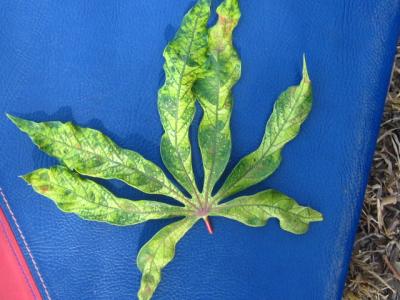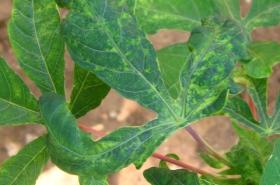Credits: Biovision-Infonet

(c) A.A. Seif, icipe

(c) A.A. Seif, icipe
African cassava mosaic disease is one of the most serious and widespread diseases throughout cassava growing areas in Africa, causing yield reductions of up to 90%.
It is spread through infected cuttings and by whiteflies (Bemisia tabaci).
Symptoms occur as characteristic leaf mosaic patterns that affect discrete areas and are determined at an early stage of leaf development.
Symptoms vary from leaf to leaf, shoot to shoot and plant to plant, even of the same variety and virus strain in the same locality. Some leaves situated between affected ones may seem normal and give the appearance of recovery.
What to do:
- Use disease-free cuttings. If it is not possible to find cassava plants that are completely free from the disease, select cuttings from stem branches instead of from the main stem. Stem cuttings from the branches are more likely to sprout into disease-free plants than stem cuttings from the main stems (James et al, 2000).
- Resistance to ACMD has been successfully incorporated into high yielding cultivars of acceptable quality through breeding programmes at IITA. Use resistant/tolerant varieties (e.g. “SS 4”, “TMS 60142”, “TMS 30337” and “TMS 30572”)